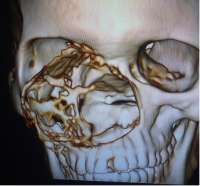A 6-year Retrospective Review of Indications and Computed Tomographic Imaging Findings of Neuro-ophthalmic and Orbital Disorders in Kaduna
Main Article Content
Abstract
Background: Neuroimaging is an important modality for the investigation of neuro-ophthalmic and orbital conditions. These investigations are expensive but describe the diagnostic yield of neuroimaging in patients referred for neuro-ophthalmic services. The aim of this article is to find the common clinical indications for orbito-cranial computed tomography (CT), and to compare the CT findings.
Method: Retrospective review of records for referral indications and CT findings of 211 patients referred to the radiology department of National Ear Care Centre (NECC) for imaging between January 2017 and December 2022. Statistical Package for Social Sciences version 26 software was used for data analysis.
Result: Both presenting complaints and CT findings were diverse, with proptosis having the highest frequency (14.75%), followed by those with loss of vision (11.27%). The CT showed periodontal mass and soft tissue swelling (16.26%) as the lead finding, followed by proptosis (12.67%) and paranasal masses (12.04%).
Conclusion: Computed tomography has become the primary radiological procedure for the diagnosis and management of most orbital and ocular disorders. It is useful in characterizing and localizing almost all lesions in ophthalmology.
Downloads
Article Details
Section

This work is licensed under a Creative Commons Attribution-NonCommercial-ShareAlike 4.0 International License.
The Journal is owned, published and copyrighted by the Nigerian Medical Association, River state Branch. The copyright of papers published are vested in the journal and the publisher. In line with our open access policy and the Creative Commons Attribution License policy authors are allowed to share their work with an acknowledgement of the work's authorship and initial publication in this journal.
This is an open access journal which means that all content is freely available without charge to the user or his/her institution. Users are allowed to read, download, copy, distribute, print, search, or link to the full texts of the articles in this journal without asking prior permission from the publisher or the author.
The use of general descriptive names, trade names, trademarks, and so forth in this publication, even if not specifically identified, does not imply that these names are not protected by the relevant laws and regulations. While the advice and information in this journal are believed to be true and accurate on the date of its going to press, neither the authors, the editors, nor the publisher can accept any legal responsibility for any errors or omissions that may be made. The publisher makes no warranty, express or implied, with respect to the material contained herein.
TNHJ also supports open access archiving of articles published in the journal after three months of publication. Authors are permitted and encouraged to post their work online (e.g, in institutional repositories or on their website) within the stated period, as it can lead to productive exchanges, as well as earlier and greater citation of published work (See The Effect of Open Access). All requests for permission for open access archiving outside this period should be sent to the editor via email to editor@tnhjph.com.
How to Cite
References
Cellina M Cè M, Marziali S,Irmici G, Gibelli D, Oliva G and Carrafello G. Computed tomography in traumatic orbital emergencies: a pictorial essay—imaging fndings, tips, and report flowchart. Insights into Imaging (2022) 13:4 https://doi.org/10.1186/s13244-021-01142-y.
Vela-Marín AC, Seral Moral P, Bernal Lafuente C, Izquierdo Hernández B. Diagnóstico por la imagen en neuroftalmología. Radiología. 2018; 60: 190-207.
Akinmoladun JA, Adeyinka AO, Uchendu O, Akinmoladun VI. Evaluation of the effectiveness of computed tomography in the diagnosis of orbital tumours in Ibadan, south west Nigeria. Journal of the West African College of Surgeons, 2013; 3 (3): 46-62.
Ogbeide E, Theophilus AO. Computed tomographic evaluation of proptosis in a Southern Nigerian tertiary hospital. Sahel Medical Journal, 2015; 18 (2): 66-70
Osaguona VB, Ogbeide E. Indications for Cranial Computed Tomography Scan in Ophthalmology: Experience at a Tertiary Hospital in Southern Nigeria. Niger J Ophthalmol 2017; 25: 133-6.
Malhotra A, Minja FJ, Crum A, Delilah Burrowes D. Ocular Anatomy and Cross-Sectional Imaging of the Eye. Seminars in Ultrasound, CT and MRI. 2011; 32 (1): 2-13.
Pradhan E, Bhandari S, Ghosh YK. The indications for and the diagnostic yield of imaging in neuro-ophthalmic and orbital disorders. Nepal J Ophthalmol 2015; 7 (14): 159-163,
Baduku TS, Yusuf A, Thompson M. Stroke in Babcock University Teaching Hospital, Nigeria: a two-year retrospective study of CT imaging findings. Bo Med J. 2022; 19 (2): 1-8.
Koukkoulli A, Pilling JD, Patatas K, El-Hindy N, Chang B, Kalantzis, G. How accurate is the clinical and radiological evaluation of orbital lesions in comparison to surgical orbital biopsy? Eye. 2018; 32: 1329–1333
Gandhi,RA, Nair,AG. Role of imaging in the management of neuro-ophthalmic disorders. Indian Journal of Ophthalmology 2011; 59 (2): 111-116.
Hounsfield GN. Computerized transverse axial scanning (tomography): Part 1. Description of system. Br J Radiol 1973; 46: 1016-22.
Kim JD, Hashemi N, Gelman R, Lee AG. Neuroimaging in ophthalmology. Saudi Journal of Ophthalmology, 2012; 26: 401–407.
Mehta S, Loevner LA, Mikityansky I, Langlotz C, Ying GS, Tamhankar MA, et al. The diagnostic and economic yield of neuroimaging in neuro-ophthalmology. J Neuroophthalmol 2012; 32: 139-44.
Wu AY, Jebodhsingh K, Le T, Law C, Tucker NA, DeAngelis DD, et al. Indications for orbital imaging by the oculoplastic surgeon. Ophthal Plast Reconstr Surg 2011; 27: 260-2.
Farooq K, Malik TG, Khalil M. Demographic, Clinical and Imaging Patterns of Proptosis. Pakistan Journal of Medical & Health Sciences 2010; 4 (3): 179-183
Chawla A, Jain S. Can we reduce neuroimaging in ophthalmology? Neuro-ophthalmology 2011; 35: 308-9.
Annam V, Shenoy AM, Raghuram P, Annam V, Kurien JM. Evaluation of extensions of sinonasal mass lesions by computerized tomography scan. Indian J Cancer 2010; 47: 173-8.
Singh N, Eskander A, Huang SH, Curtin H, Bartlett E, Vescan A, et al. Imaging and resectability issues of sinonasal tumors. Expert Rev Anticancer Ther 2013; 13: 297-312.

